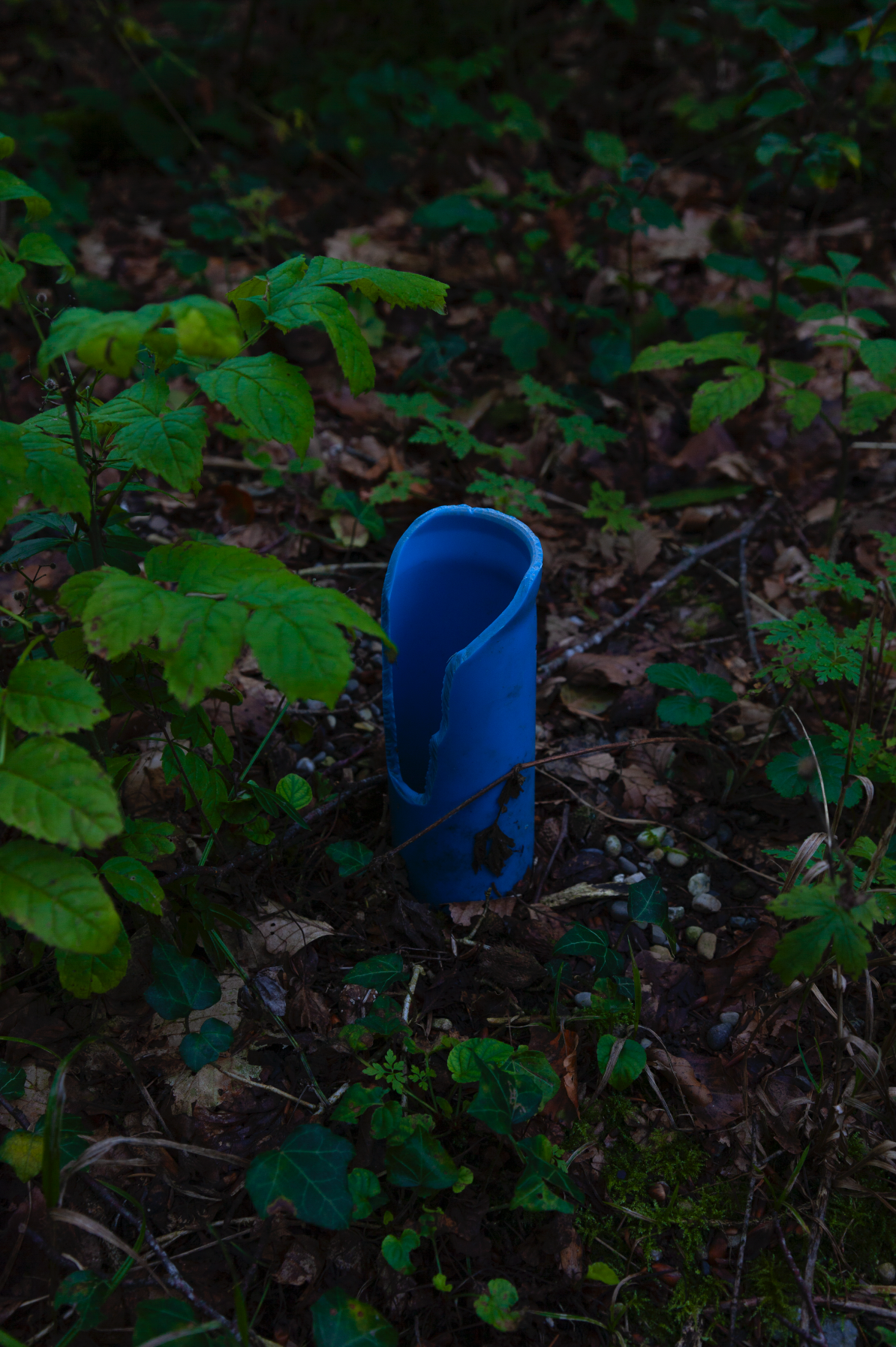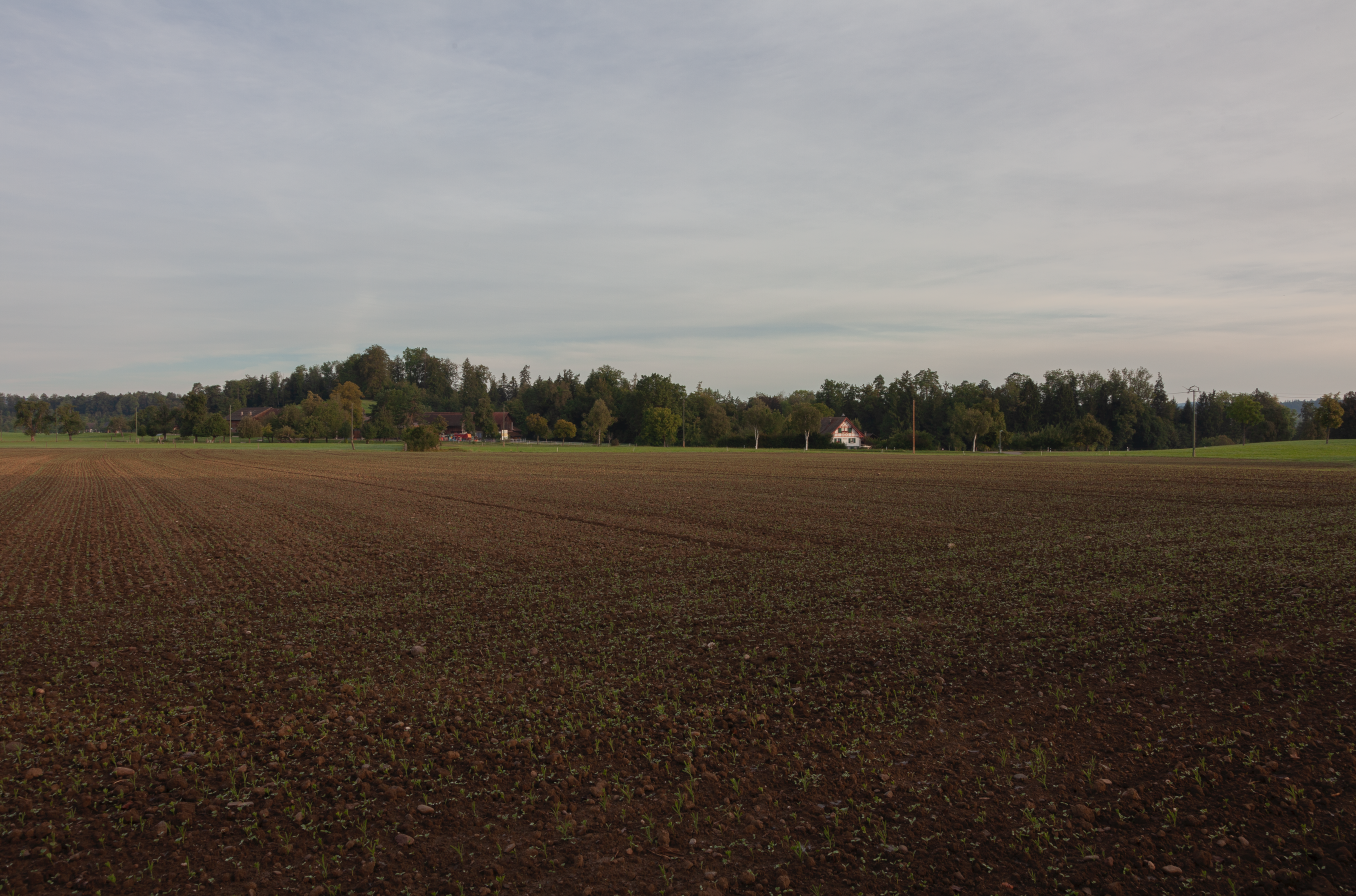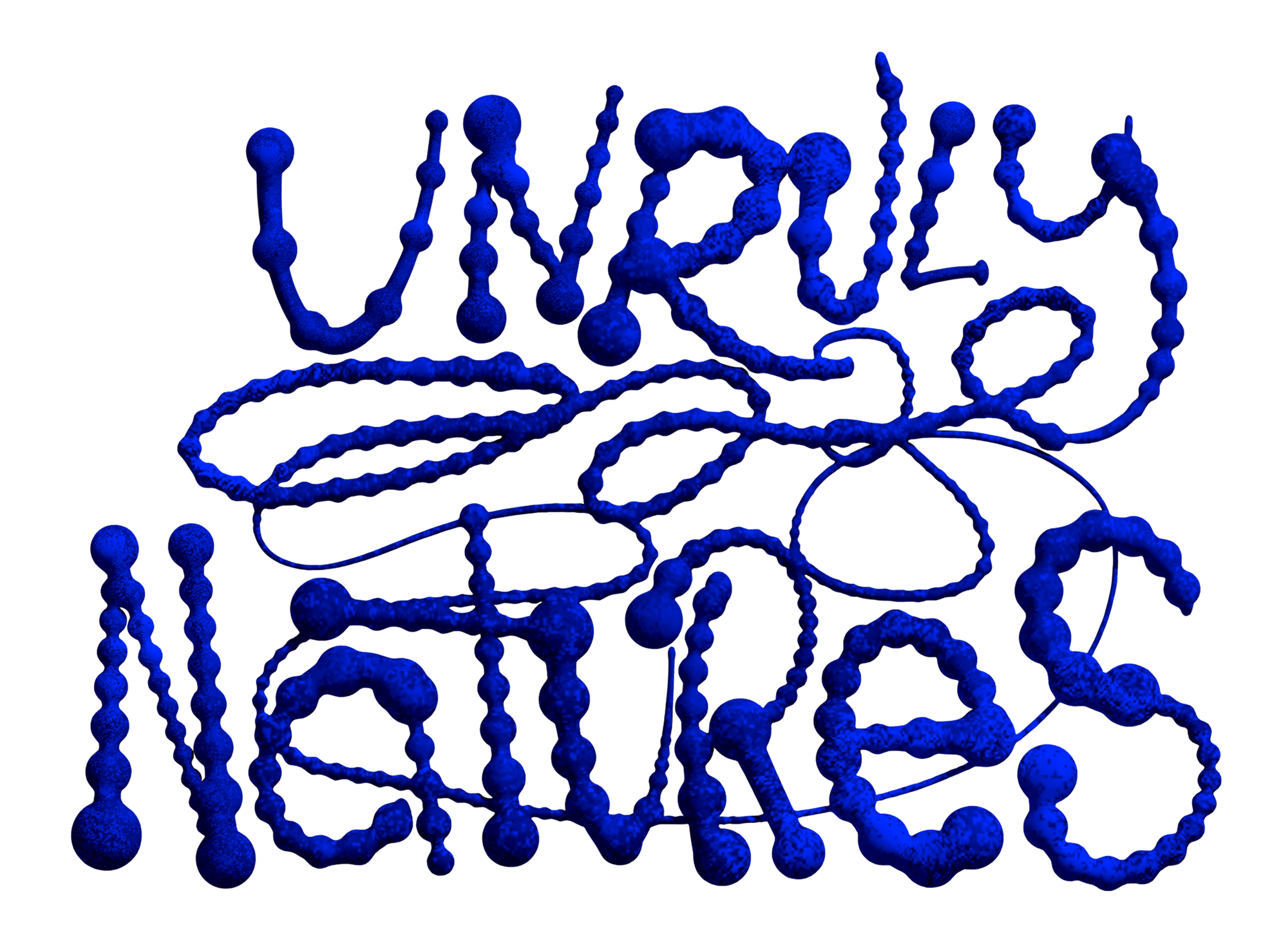Text and Photographs
by Sigrid Schmeisser
︎
March 26, 2024
A small, inconspicuous blue pipe sticks out just above the ground, right beside a gravel path in a small Swiss forest. Had Susanna not pointed it out to me, I would have entirely missed it in the warm October sun that directed my camera’s gaze elsewhere.
Together, we are walking on the borders of a future landfill and if local activists have their say, its dotted lines will remain on paper only. Susanna, a lively 60-year-old woman and local council member, has become a leading figure in the activists’ campaign, titled ›DepoNIE‹ (a German wordplay translated as DumpNever).
For more than ten years, her group has been engaged in relentless demonstrations and debates with the canton Zurich (one of 26 federate states of Switzerland) to save the 10-hectare ecosystem named Tägenauerholz in Grüningen, 20 km from Zurich. The seemingly innocent blue pipe carries thus more meaning and has turned into a silent witness of the conflict, for it is a left-over artefact from when ground samples were taken in secret to determine the site’s suitability. Crucially, these tests were done before the forest was officially up for debate.1
 Aerial view on the 10-hectare forest Tägernauerholz, Grüningen near Zürich.
Aerial view on the 10-hectare forest Tägernauerholz, Grüningen near Zürich. By and large, areas destined to be made into sacrificed zones might formerly have been clay deposits and extraction sites such as the Flemish mountain2, sandpits, old quarries or other locations deemed worthless for any other activity.3 Meanwhile, in Grüningen, «a simple circle on a map right in the middle of the forest» would unleash years of conflict.4 A safe dumping ground for the residues of recycling had to be found. So both the canton and the local waste company were evaluating suitable sites across their legal territory — not least because they were expecting more demand for disposal space due to the growing population there.
In the end, the canton’s final decision fell on this forest. Long-distance transports could be avoided by the company’s proximity to the site, and unnecessary CO2 emissions could therefore be minimised. Better, more CO2 would be saved that way than what the forest of 7,000 trees supposedly absorbs.5 So went their reasoning.
In the end, the canton’s final decision fell on this forest. Long-distance transports could be avoided by the company’s proximity to the site, and unnecessary CO2 emissions could therefore be minimised. Better, more CO2 would be saved that way than what the forest of 7,000 trees supposedly absorbs.5 So went their reasoning.

Silent witnesses, left-over artefacts from ground sampling.
The activist group was angered by these conjectures, which appeared to treat a symptom—waste recycling —and neglect its cause. And even though Susanna has told the story of political and economic entanglements over and over again, she is not too tired of it to walk me and my camera through every detail.
On our way, we encounter Jakob Bodmer, a state forester and, in effect, the caretaker of Tägenauerholz. He is the fourth generation of his family in this job and has been tending the site for more than 30 years, all the while adding more tree species to enhance its biodiversity overall. Unfortunately, his efforts haven’t been enough. When ProNatura—a Swiss conservation organisation—concluded their report, they suggested that the forest didn’t bear much value. According to Susanna, the judgement relied on the forest’s outdated classification as a commercial timberland (Nutzwald). As we leave, I can tell Bodmer is visibly affected by the fight to prove otherwise.6
Beyond the fight to keep ecosystems intact, the role of the tree and our perception is interesting in these discussions. Ever since the environmental movement of the 1980s, trees emerged as devices to absorb air pollution, and visions to plant millions of trees have appeared since. Visions of planting millions of trees have appeared since. Amongst its proponents are the U.S. Forest Service and National Geographic. While the latter asks for more trees to be planted to combat climate change, the former baldly states on its website »trees work for us«, before listing some of their advantages.7 Portrayed as providing a service to the ecosystem, trees have been inserted into our economic framework as «natural capital», thereby reducing them to their mere biological processes, their ›use‹ and economic value to humans.
This sets them up to become a mere object to either offset ecological degradation caused by extractivism, or vulnerable to competing economic and «ecological» arguments.8
The case of Tägenauerholz is thus almost a textbook example of this reductionist approach, even though it is turned upside down. Instead of being portrayed as mitigating the damage of industrial processes and emissions, this time, trees have been turned into the geospatial ›other‹. In this sense, the Wasteocene Armiero describes9 doesn’t produce a static, unmovable version of this ›other‹. Rather, as Tägenauerholz demonstrates, borders are ever-shifting in response to the prevalent agenda, ensuring the smooth continuation of ›the centre‹.
 Early morning views from adjacent Grüningen dwellings.
Early morning views from adjacent Grüningen dwellings.
I walk with Susanna all the way to the bottom of the forest, where we encounter a small stream. If the activists lose their fight against the canton, it would need to be diverted. The sheer effort to transform the sloped forest into a landfill only propels the group to act even more.
Susanna pulls out a handful of laminated images: One shows several helium balloons in the air to visualise how high the site would become, a staggering 20–30 m, similar to a high-rise building. Another is a contrasting visualisation of the forest with and without the landfill. It appears that a few trees would be left surrounding the site to upkeep the idyllic notion of intact nature–a common strategy also found in the Netherlands. The next shows the group dressed as wild animals; it carries comical tones.
Minutes later, the image turns bittersweet as Susanna explains that proving the forest’s biodiversity, contradicting ProNatura, might be one of the few arguments left to the group. At least according to their legal representative (the only law firm willing to take the case). She tells me that many law companies declined as they feared they would lose lucrative site survey contracts and other types of governmental employment.10
To persuade the community and DepoNie, the canton waved a final trump card: technological progress. In their vision, Tägenauerholz would only be temporarily required as a storage site for 20–30 years at most. By then, technology should be ready and economically viable to extract valuable minerals from the clinker. Upon completion, the site could be remediated and the forest restored. In reality, it would take decades for the 10-hectare site to grow close to today’s size and biodiversity. A full ›restoration‹ might never happen either as the cost tends to be relatively high against the perceivable gains, which is why only landfills posing measurable risks tend to be fully remediated.11 This new chapter, another form of carbon imaginary, poses a novel, rather strange problem for DepoNie:
From trading wastes against ecosystems, they will now be up against a speculative future perfect, where the «damage will have been undone».12
In this unfolding future, resources are judged ever more on their perceived characteristics and value at any given moment. In tandem, the definition of the ›other‹ will depend there-on. Meanwhile, the centre is awakening to its collateral damage and still reassures with the promise of technology securing its survival. «Away»13 has received a new temporal dimension that banks on a future undoing which may or may not arrive.
«From Centre to Periphery» is a long-term design & research project that investigates discarding, the role of landfills as an antiquated disposal method and their entrenchment within contemporary waste management. Constructed ever further on the periphery, landfills have become a «geospatial other» destined to receive the residues of waste incineration, hazardous waste, and recycling streams, which to this day enables the centre14 to flourish and thus necessitates the landfills’ existence. The project comprises several chapters and includes field research, sound recordings, interviews, and photography of various sites across the Netherlands, Switzerland, Belgium and Scotland. The article above is an excerpt from Schmeisser’s case study of Tägenauerholz near Zurich and its broader implications.
If you are interested to learn more about the activities in Tägernauerholz, please take a look at the articles «Unruly Grüningen» and «Tägernauerholz – The Forest Being and Political Resistance».
About the author: learn more about Sigrid Schmeisser here
If you are interested to learn more about the activities in Tägernauerholz, please take a look at the articles «Unruly Grüningen» and «Tägernauerholz – The Forest Being and Political Resistance».
About the author: learn more about Sigrid Schmeisser here
Footnotes
1 Personal conversation with Jenny, Susanna, DepoNIE, 26.10.2022, Kanton Zürich, Grüningen (CH).
DepoNIE (n.d.), 8 Gründe dagegen–DepoNie Tägernauerholz. Available at: depo-nie.com/8-gruende-dagegen (Accessed: 31.10.2022).
Samuel, S. (2019). Bitte hier keine Schlacke deponieren. Hochparterre, p. 32–37.
Ledebur, M. von (2018) ›Der Schweizer Wald ist nicht unantastbar–in Zürich soll er einer Deponie weichen‹, Neue Zürcher Zeitung, 19.6.2018. Available at: nzz.ch/zuerich/warum-der-regierungsrat-eine-deponie-mitten-im-wald-plant-ld.1395973 (Accessed: 21.11.2022).
2 A reference to a landfill in Belgium, in which clay is mined and sold whereas at the same time hazardous waste has been landfilled for lack of alternatives.
3 Personal conversation with Mars, Jan Frank, EU COCOON project (NL contact), 28.09.2022.
Personal conversation with Wille, Eddy, EU COCOON project (BE contact), 23.9.2022.
4 Personal conversation with Jenny, Susanna, DepoNIE, 26.10.2022, Kanton Zürich, Grüningen (CH)
5 Samuel, S. (2019). Bitte hier keine Schlacke deponieren. Hochparterre, p. 32–37.
6 Personal conversation with Jenny, Susanna, DepoNIE, 26.10.2022, Kanton Zürich, Grüningen (CH)
7 US Forest Service (2021), Trees. Available at: fs.usda.gov/learn/trees (Accessed: 3.1.2023).
Mandel, K. (2021), ›Planting trees helps fight climate change—but we need billions more seedlings‹, NationalGeographic (2.3.2021). Available at: nationalgeographic.com/environment/article/planting-trees-helps-fight-climate-change-but-we-need-billions-more-seedlings (Accessed: 3.1.2023).
8 Cooking Sections: Offsetted (2019) e-flux, announcements, 6.2.2019. Available at: e-flux.com/announcements/247736/cooking-sectionsoffsetted/ (Accessed: 9.1.2023).
9 The Wasteocene is a term coined by Marco Armiero, in order to draw a clear distinction between the producers of the toxic narratives, slow violence and pollution and those on the receiving end (What I call the »geospatial other«). The term Anthropocene implies, for instance, that indigenous communities are as equally responsible for this epoch as their conquerors (see Max Liboiron), when in fact only particular (›imperial‹) socio-economic life¬styles have led to the current situation.
10 Personal conversation with Jenny, Susanna, DepoNIE,26.10.2022, Kanton Zürich, Grüningen (CH)
11 Samuel, S. (2019). Bitte hier keine Schlacke deponieren. Hochparterre, p. 32–37.
12 Personal conversation with Jenny, Susanna, DepoNIE, 26.10.2022, Kanton Zürich, Grüningen (CH)
13 The project attempts to dissect the language that is used within contemporary waste management, yet also cultural narratives such as «away», that deep down citizens know doesn’t really exist, yet that is collectively enacted by industry and dwellings alike. Today, landfilling happens both due to a lack of alternatives (see hazardous wastes) and the fact that the question of material flows aka “waste” has not been solved. Tägenauerholz–destined to receive the residues of recycling processes–goes to show these alleged myths of control, where waste may be only reduced in scale and size yet not eliminated whatsoever.
14 The centre and periphery are concepts introduced to talk broadly about waste management, and the alleged disappearance of waste, typically away from or outside the producer’s property.
1 Personal conversation with Jenny, Susanna, DepoNIE, 26.10.2022, Kanton Zürich, Grüningen (CH).
DepoNIE (n.d.), 8 Gründe dagegen–DepoNie Tägernauerholz. Available at: depo-nie.com/8-gruende-dagegen (Accessed: 31.10.2022).
Samuel, S. (2019). Bitte hier keine Schlacke deponieren. Hochparterre, p. 32–37.
Ledebur, M. von (2018) ›Der Schweizer Wald ist nicht unantastbar–in Zürich soll er einer Deponie weichen‹, Neue Zürcher Zeitung, 19.6.2018. Available at: nzz.ch/zuerich/warum-der-regierungsrat-eine-deponie-mitten-im-wald-plant-ld.1395973 (Accessed: 21.11.2022).
2 A reference to a landfill in Belgium, in which clay is mined and sold whereas at the same time hazardous waste has been landfilled for lack of alternatives.
3 Personal conversation with Mars, Jan Frank, EU COCOON project (NL contact), 28.09.2022.
Personal conversation with Wille, Eddy, EU COCOON project (BE contact), 23.9.2022.
4 Personal conversation with Jenny, Susanna, DepoNIE, 26.10.2022, Kanton Zürich, Grüningen (CH)
5 Samuel, S. (2019). Bitte hier keine Schlacke deponieren. Hochparterre, p. 32–37.
6 Personal conversation with Jenny, Susanna, DepoNIE, 26.10.2022, Kanton Zürich, Grüningen (CH)
7 US Forest Service (2021), Trees. Available at: fs.usda.gov/learn/trees (Accessed: 3.1.2023).
Mandel, K. (2021), ›Planting trees helps fight climate change—but we need billions more seedlings‹, NationalGeographic (2.3.2021). Available at: nationalgeographic.com/environment/article/planting-trees-helps-fight-climate-change-but-we-need-billions-more-seedlings (Accessed: 3.1.2023).
8 Cooking Sections: Offsetted (2019) e-flux, announcements, 6.2.2019. Available at: e-flux.com/announcements/247736/cooking-sectionsoffsetted/ (Accessed: 9.1.2023).
9 The Wasteocene is a term coined by Marco Armiero, in order to draw a clear distinction between the producers of the toxic narratives, slow violence and pollution and those on the receiving end (What I call the »geospatial other«). The term Anthropocene implies, for instance, that indigenous communities are as equally responsible for this epoch as their conquerors (see Max Liboiron), when in fact only particular (›imperial‹) socio-economic life¬styles have led to the current situation.
10 Personal conversation with Jenny, Susanna, DepoNIE,26.10.2022, Kanton Zürich, Grüningen (CH)
11 Samuel, S. (2019). Bitte hier keine Schlacke deponieren. Hochparterre, p. 32–37.
12 Personal conversation with Jenny, Susanna, DepoNIE, 26.10.2022, Kanton Zürich, Grüningen (CH)
13 The project attempts to dissect the language that is used within contemporary waste management, yet also cultural narratives such as «away», that deep down citizens know doesn’t really exist, yet that is collectively enacted by industry and dwellings alike. Today, landfilling happens both due to a lack of alternatives (see hazardous wastes) and the fact that the question of material flows aka “waste” has not been solved. Tägenauerholz–destined to receive the residues of recycling processes–goes to show these alleged myths of control, where waste may be only reduced in scale and size yet not eliminated whatsoever.
14 The centre and periphery are concepts introduced to talk broadly about waste management, and the alleged disappearance of waste, typically away from or outside the producer’s property.
